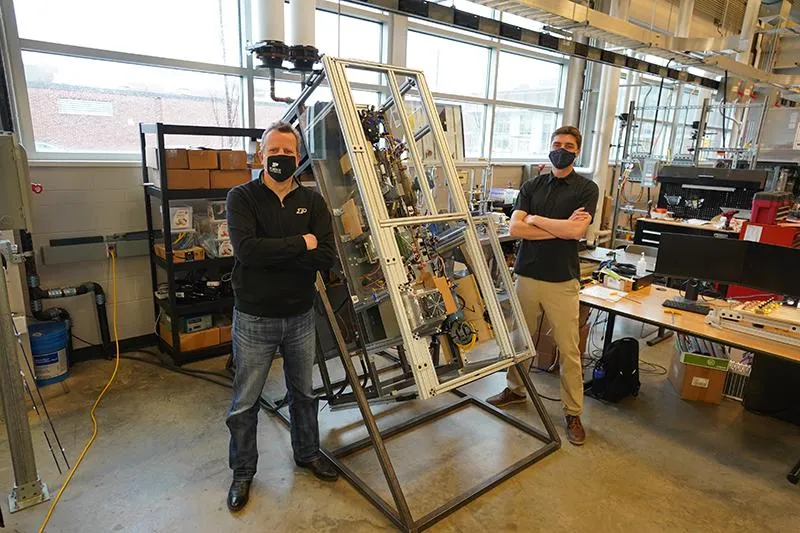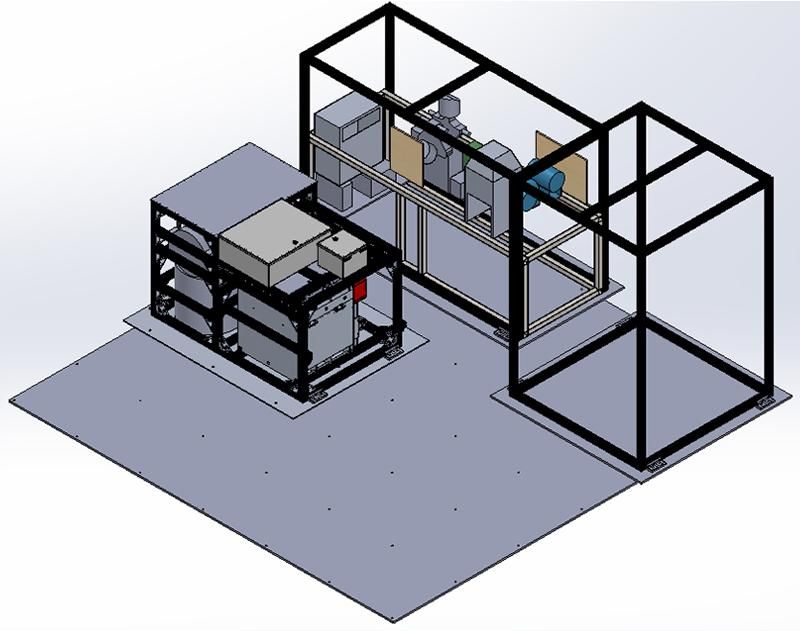The Quest to Build a Functional, Energy-Efficient Refrigerator That Works in Space
Designed and tested by Purdue University engineers, this new appliance would lengthen the shelf life of food on long missions
/https://tf-cmsv2-smithsonianmag-media.s3.amazonaws.com/filer/f9/f9/f9f97a7d-bafa-43e6-9684-f37b066dd3e2/space_fridge.jpg)
So much of our everyday lives relies on gravity. We jump, toss a ball, pour ourselves a drink and experience rain, all thanks to the natural force. Still, it’s easy to forget that even a household appliance like a refrigerator needs gravity to work. A fridge siphons heat from its frigid insides and dumps it to its immediate outside. Waste heat is removed from the fridge by circulating air, known as convection. Because of gravity, hot air rises and cooler air whooshes in to fill the space.
Engineers, however, are keenly aware of the challenges that the conditions of space present when it comes to designing a fridge.
Without gravity, the lack of an “up” or “down” prevents the formation of convection currents. On top of that, space or enclosed spacecrafts lack free-flowing air, so household fridges transplanted to those environments would overheat.
“In space, if there’s a warm item, it makes a warm bubble around [itself] and gets even warmer and warmer,” says Tobias Niederwieser, a research associate at BioServe Space Technologies, a research institute at the University of Colorado, Boulder.
A large portion of solid astronaut food is dehydrated or freeze-dried, with a shelf life of one to three years. Having a fridge in space would allow food to keep for longer, which is important for extended missions deeper into space.

Recently, a team of researchers from Purdue University, Air Squared Inc. and Whirlpool Corporation overcame these challenges to design a fridge for space, adapting the cooling technology of a household fridge to make what they claim to be the most energy-efficient model for space. Theirs has the storage capacity of a microwave and reaches temperatures as low as -4 degrees Fahrenheit. Moreover, it uses water cooling to compensate where Earth’s natural convection would have helped to remove heat from a fridge’s backend. After three years of tests, the microgravity-proof contraption is ready to be deployed on missions. Not only will the appliance extend the shelf life of space food, but it will also give long-term space travelers a few more options in what they consume, and how.
The researchers’ fridge isn’t the first model that’s adapted for space. Since late 2020, astronauts on the ISS have used two food fridges, called the Freezer Refrigerator Incubator Device for Galley and Experimentation (FRIDGE), that use a less energy-efficient cooling principle. Several now-retired fridges have flown through space as early as the 1980s. Currently, a number of freezers have been slogging away on the ISS since 2006. These cryogenic coolers dip to temperatures of minus 260 degrees Fahrenheit and serve solely as research incubators. Astronauts can’t use these fridges for food storage for fear of contaminating the precious experiment samples. Fridges for astronaut personal use don’t require the bells and whistles, like super stable temperature control and additional sensors to monitor the conditions within, present in the research versions. A simpler fridge design would do—and this time, astronaut convenience, low maintenance and energy efficiency are the top priorities.
“If you think about long missions … then the question of energy efficiency becomes also more relevant,” says Leon Brendel, a mechanical engineer at Purdue University who was part of the team that designed the new fridge. In prolonged, multiyear journeys through space, high energy efficiency would reduce the need for additional batteries or solar panels, thereby lightening the spacecraft’s load during launch.
Household fridges use the vapor compression cycle to achieve the low temperatures for storing our perishables and frozen foods. A liquid refrigerant cycles through our fridges; it vaporizes to draw heat from the inside of the fridge, similar to how the evaporation of sweat cools our bodies. When the gasified refrigerant circulates to the outside of the fridge, it jettisons the heat to the environment by condensing back into liquid.
Key to the vapor compression cycle is a fridge component called the compressor. It’s the fridge’s noise-maker, the workhorse that squeezes vaporized refrigerant to higher pressures so that, paradoxically, the gas condenses at high temperatures to force waste heat out (usually, liquids evaporate at high temperatures such as during boiling, and condense at low temperatures, similar to morning dew after a cold night). On Earth, the moving parts of the compressor are coated with oil that lubricates, cools rubbing parts and helps with pressurizing gasified refrigerant. While this oil circulates through the system, most of it accumulates in a sump at the bottom of the fridge outside of the compressor, thanks to gravity. The fridge’s mechanical parts replenish their lubricant by recycling the oil that has pooled in the catchment area.
Without gravity, the oil doesn’t drip back to the sump and the reservoir runs dry. The oil itself can seep uninhibited everywhere else and flood the compressor, causing moving parts to seize.
“You're relying on gravity to know exactly where the oil is,” says Eckhard Groll, the lead researcher and a mechanical engineer at Purdue University. In space, “how can you guarantee that the oil is where you expect it to be?” He adds, “a much easier solution was [to] take that out of the picture.”
The researchers turned to oil-free compressors, similar to those used in the medical field for wielding surgical instruments and life-saving ventilators. The team modified existing designs to match the pressure requirements for their fridge. To cool the moving elements as an oil lubricant would have, the researchers channeled flowing water along the outsides of these parts.
Then, the researchers ran their fridge on its side and upside down, confirming that it operates normally in flipped orientations. In a normal fridge, the oil lubricant would flood the compressor, causing it to choke and splutter. But not this fridge, thanks to the lack of the lubricant. The successful result prompted the researchers to ponder the next big challenge: a test drive in microgravity.
To mimic the lack of gravity in space, the researchers operated their fridge on parabolic flights, inside a plane that arcs through Earth’s atmospheres at high altitudes to give passengers the same weightless feeling of riding a roller coaster, or traveling in space. In May this year, the fridge took 30 parabolic flights, each providing 20 seconds of simulated microgravity. The verdict: the fridge would function in space. The researchers didn’t observe any flooding of the liquid refrigerant in the compressor, which could have backflowed into the device.
“We have now a higher confidence in this technology to be reliable in a microgravity environment,” says Groll. The researchers are also in talks with private companies interested in exploring the technology for other applications beyond storing astronaut foodstuff.
“The technology is cool in itself,” says Niederwieser, who wasn’t involved in the project. “Their system is the system we use in pretty much all [air conditioners] and fridges that we have here on the ground.”
There’s a reason why vapor compression technology is so prevalent on Earth. “It’s the most efficient way to get to cooler temperatures,” he adds.
Niederwieser and his BioServe colleagues have built space fridges themselves; they’re the masterminds behind the two personal-use FRIDGES already on the ISS. These appliances use thermoelectric cooling to generate cold surfaces, no fluids or compressors involved, and haven’t had any hitches since their installation. Still, Niederwieser says that the diversification of cooling technologies is a welcome trend.
“Developing a compressor you can turn around [in every direction] has even some benefits for Earth,” he adds. He gives examples of high-end fridges that can survive the tumble and jostling of rickety transportation, or itinerant coolers that can be used instantly and on the go as they won’t have to wait for all the liquids to drain to the bottom. “So, even not for space, I'm sure there are plenty of opportunities,” he says.

Niederwieser, Groll and Brendel can’t pinpoint which cooling technology makes for the best fridge, because it depends on the criteria that engineers are optimizing for. In terms of energy efficiency, vapor compression is the best bet. Niederwieser’s thermoelectric version has no moving parts or liquids, so he says his system is maintenance-free.
Brendel says that maintenance is also part of his team’s design considerations. “The goal is that no astronaut would have to touch it,” he says. But right now, it’s unclear how long their fridge can last in space. “Our project was only three years long,” he says, but it lasted that long without hiccups. “Obviously, we have not done a 10-year-long study.”
As Niederwieser puts it, “The first time we deliver [a] fridge to astronauts is the first time we can really test how it's working.”
Ultimately, a food-specialized fridge for space travelers is a luxury, not a necessity. In the past, astronauts have repurposed old research fridges to freeze their fare. Only in 2020 did food fridges become fixtures on the ISS, when Niederwieser’s FRIDGE became the first for storing food exclusively, and astronauts seem to appreciate them so far.
Having an astronaut fridge in space “really adds to the crew’s morale,” says NASA astronaut Victor Glover, who just returned from his 168-day stint on the ISS in May this year. It increases the options of how astronauts take their food, spicing up the diets of spacefarers who endure months-long sojourns and have mostly freeze-dried food to look forward to each day. For example, Glover would occasionally refrigerate his favorite dish in space, sweet-and-sour kale that’s normally meant to be eaten hot, just to switch things up. He says that he and his former crewmates use ISS’s fridges to chill drinks, condiments and medication. (He also adds that they have never, ever squabbled over fridge space.) “A fridge just adds one more piece of familiarity—the way that we do things on the ground,” says Glover.
Moreover, with space tourism on the rise, billionaires who can afford a private ticket to space may also want to travel in comfort. After spending millions of dollars to hitch a ride to beyond Earth’s atmosphere, perhaps an inflight cold drink might not be too much to ask for.
/https://tf-cmsv2-smithsonianmag-media.s3.amazonaws.com/accounts/headshot/kim.png)



/https://tf-cmsv2-smithsonianmag-media.s3.amazonaws.com/accounts/headshot/kim.png)